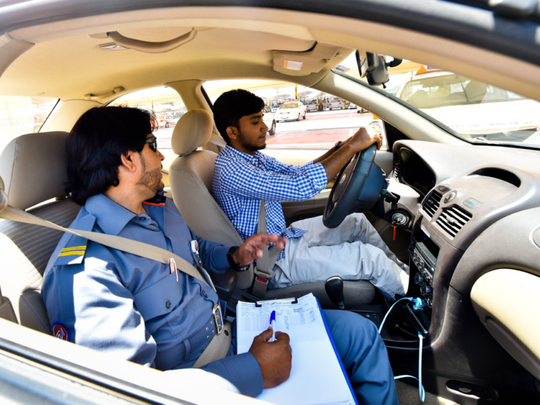
Dubai: Learner drivers will have to take a minimum of an hour’s lesson per day from January next year, as the Roads and Transport Authority (RTA) restructures the driver’s training programme, Gulf News can confirm.
The RTA confirmed to Gulf News that the way the minimum training duration is calculated will change from next year, virtually banning the 30-minute classes.
Right now, beginners (without any prior driving experience) have to take a minimum of 40 classes of 30 minutes each. However, from January this will change to 20 hours with a minimum of an hour per lesson.
Though, there is no change to the minimum training hours, RTA feels hourly training will give the course a better structure.
Arif Al Malek, director, Drivers Training and Qualifications at RTA’s Licensing Agency, confirmed that though there is no increase in the minimum classes, there will be a change in the calculation of training duration from 40 classes to 20 hours, with effect from January 1, 2017.
“From January 1, all lessons will be on an hourly basis and not for half an hour, which is the case now. A student will have a maximum training of four hours per day. We constantly study and revise the curriculum to update the necessary knowledge and skills that are required for new drivers. This is an ongoing process,” said Al Malek.
He added that for every two hours of practical training, there must be at least an hour’s interval, after which students can continue their training for another two hours.
However, he cautioned trainees that the minimum lessons do not reflect the training classes required to acquire a driving licence.
“As we all know, all learners have different learning abilities and require different number of classes. Students should not be under the impression that they will be ready to take the road test with 20 hours of training. It is the responsibility of driving institutes, instructors and assessors to ensure the students are trained to the required standard before sending them for RTA road tests,” he said. Urging driving schools not to send candidates for road tests as long as they do not perform at a satisfactory level, he added that there is no maximum limit for training.
“The training can go well beyond the minimum 40 classes. It only misleads students to believe that 40 classes is what they need,” he added.
He said that having the students thoroughly trained is in the favour of everyone.
“The pass rate is an important key performance indicator. A higher pass rate is a win-win situation for the students, schools and RTA. We monitor the schools’ passing rates. This has an impact on the students’ interest as well as the whole industry,” he explained.
He added that RTA is putting a system in place where the instructors will be held responsible for the performance of the learners.
“If the instructors are not held responsible for the pass rate, they may not put in enough effort in coaching the students in handling of the vehicle and nurturing safe drivers. We already have a system that has school assessors who assess the student and ensure he/she meets the standard before being allowed to go for RTA road test,” he said.
According to the system, the assessors are also held responsible if they allow unprepared students to go for a test without filtering.
“Before students book the practical driving test, it is a requirement that the students must pass the driving assessment test by the school. If they do not meet the requirements, they are not allowed to go for road test,” Al Malek said.
Expert views
Minimum one hour per day will improve training: schools
Robert Hodges, COO of Emirates Driving Institute, agreed that proposed changes will improve student training quality, although a minimum 20 hours training is woefully inadequate for a beginner learner.
“International best practice from Western countries has shown that typical new learners require between 35 and 55 hours of training with an instructor to gain adequate competency to pass a meaningful road test. Often [in other countries] their laws require additional private practice to also take place between formal lessons with an instructor,” said Hodges.
He also insisted that students and their family members should not imagine that 20 hours will be adequate to become a safe driver and to pass the RTA road test.
He also commended RTA for limiting the classes to a minimum of one hour.
“I have always had the policy of recommending a minimum student booking of one hour, and thus have always encouraged students to book two-hour slots. This enables improved learning to take place, and more better quality student driving time with only one exit from school premises and one return required, and lots more time for the student to settle into the process, become more competent and fluid in the use of control,” he added.
Ian Littlefield, Training and QHSE manager at Dubai Driving Centre, called the reshaping of the minimum required training periods a positive step.
“Many students, despite being told many times, still believe that they will be ready to take a test within this minimum period and complain that 40 classes in particular is a long time, though the average student takes around 70-80 classes or 35-40 hours to be ready to take the RTA road test and some need considerably more,” he said.
He added that the restructuring will psychologically help learners to better cope with the training.
“Psychologically, 20 hours sounds less than 40 classes and so people will feel better about taking the additional training required to make them a safe driver,” he said.
Speaking about the new structure he added: “The number of hours that can be taken in a day is restricted so that students do not become overloaded with information and forget what they have learnt. Two hours at a time is really the maximum continuous period of training we would recommend for this reason and a 60-minute break will allow the student to think about what they have learnt and refresh themselves before the next class.”












